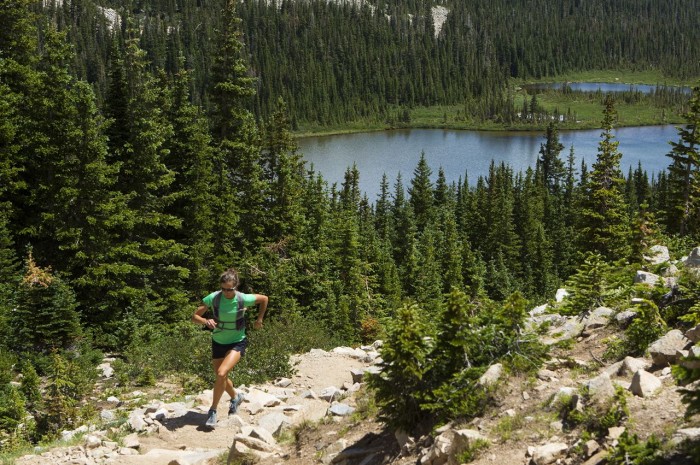Krissy Moehl’s Tips for Running in Heat

It’s ultra hot and you’re heading out for a run. But how prepared should you be for running in heat?
“In summer, especially in higher altitudes and warmer temps, one can endure sunburn, blisters, dehydration, cramping, heat exhaustion, and even heat stroke if proper planning isn’t made for the run course and time duration,” says professional ultrarunner and Patagonia ambassador Krissy Moehl, who has won such epic races as the 2009 Ultra-Trail du Mont-Blanc, where she holds the current course record.
Despite the challenges, Moehl says that summer is her favorite running season. “I love where we’re able to visit during the summer—the amazing peaks that are melted out and open and their low-lying meadows are definitely my favorite aspects of summer running,” she says.
Here, Moehl tells us a little bit about herself—and how to do some simple prep that will keep you moving in summer’s heat.
WomensMovement.com: What’s your favorite time of year—and temperature range—in which to run?
Krissy Moehl: I love variety and changing seasons. But when push comes to shove I absolutely love putting a little sunscreen on my shoulders and neck, and tossing on a great tank, sports bra, skirt, ankle socks, and shoes and cruising out my door into the surrounding peaks on a early summer morning.
Where goosebumps spring up on my arms as I walk out the door with a water bottle in hand, but quickly dissipate as my own temp rises in movement. Where the sunglasses are on my head when I leave and on my face within a couple of miles as the sun comes up and the air temp rises. I love these temps because they are easy—the clothing is simple and the running is about the time out there moving without too much worry about body and/or gear management.
WM: What are the dangers of summer running?
Krissy: The dangers of summer running—or any kind of running—are under-preparation for the conditions. Whether it’s hot or cold, how a runner preps for the adventure is where the risk lies.
I recently got the great idea to run four repeats on Green Mountain. It turned out the day was over 90F and I was going through water much faster than I anticipated. I carried a 70-ounce bladder up each trip (it was just over one hour to the top) and was basically out by the time I reached the top and had to manage my body for the descending miles. I chose to modify my route so that I could finish my goal (same amount of summits, a little shorter on the mileage) and spent the rest of the evening sucking down as many fluids as possible and the next couple of days getting the bounce back in my legs. I was mostly prepared for the run, but definitely could have carried more water along the route.
WM: How much water should runners be drinking when running in summer heat?
Krissy: Every body is different. There’s a great test each person can do at different times of the year to know what their hydration needs are—it’s called the Sweat Rate Test. It’s good to try this test during different temperatures and altitudes because your body will have varying needs depending on both.
1) Weigh yourself naked and dry before you run.
2) Run for one hour—do not urinate during the run or before weighing yourself again.
3) Weigh yourself naked and dry after the run.
4) For each pound lost you need to consume 16 ounces of fluid. Keep in mind that often water alone is not enough; electrolytes and trace minerals are a key part of hydration replenishment.
* Overall, most runners need around 16 to 24 ounces of water per hour depending on the conditions.
WM: What are your 4 best tips for running in heat?
1. Find sunscreen that lets your skin breathe.
2. Carry hydration with you even when you think you may not need it.
3. In super-hot weather it’s good to wear clothing that actually retains a bit of moisture to help keep your skin cool. Fast-drying fabrics are awesome to avoid chafing, but in hot conditions the bit of moisture in the fabric can help keep you cooler so that you won’t sweat as much.
4. If you’re training for a race it’s good to train in the conditions that you may endure during the event. Therefore, if the race is going to be hot, it would be good to run during the hotter part of the day so that you can figure out what your body needs to do to adapt to the conditions.
WM: With summer’s wildfires upon us, is it safe to run in somewhat smoky conditions or should we head to the gym or yoga instead?
Krissy: Listen to the reports and pay attention to the winds and what they predict regarding the severity of the air quality. I’ve run in bad air quality and it caused an icky upper respiratory infection—it’s not worth it.
Kamagra oral jelly Online something to buy the most convenient way. He doesn’t demand from you any actions except how to visit the website. And in separate with goods necessary to you to put the end. To specify your address and to wait for the supplier to whom you will give money.



July 31st, 2013 at 11:54 am
Thanks for sharing this post! I think it will inspire many people to take the plunge and start running. Anyone can run in the heat. They just need to challenge themselves to get started!